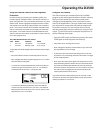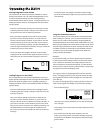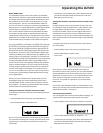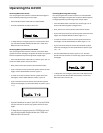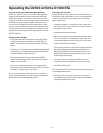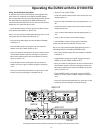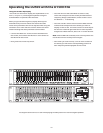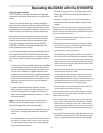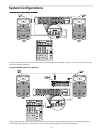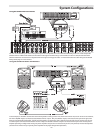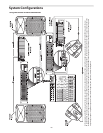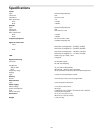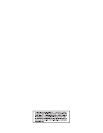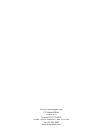
23
• Now run your mic, MP3, or CD player signal, press
RTA on the D1500 and check the LCD Meters on
the D1500.
• While the D1500 is set to RTA, you may need to
adjust the GAIN to set the reference point of the
display.
Once you confirm that the system is operating normally
and that the RTA can read the system response with the
test mic, you can move ahead and generate the Pink Noise
to help you flatten the system.
• Connect the D1500 Left and Right Outputs to a pair of
inputs on your mixing console.
• Now make sure that the input gain controls and faders
on the inputs on your mixers have the D1500 outputs
connected and turned up to about 0dB.
• Press the GEN switch on the D1500.
• To change the operating
level
reference scale press the
REF switch and use the Data Wheel to make the change.
• To be extra safe with your gear (this may get really loud!
really!), start with a very low signal level by selecting the
GAIN switch and turning the Data Wheel counter-clock-
wise all the way to –98dB.
• Next, press the SOURCE switch and turn the Data Wheel
until the display reads: SRC: PINK.
• To turn up the Pink Noise signal, make sure that GEN is
still selected and then press the GAIN switch and turn
the Data Wheel clockwise until your hear the level of the
pink Noise get about as loud as the system was when
you played your mic, MP3, or CD player signal,
• Now, press the RTA switch and you should see the vari-
ous frequency meters bouncing along.
If the LED meters read very low on the display, or the you
don’tsee them at all, you will need to do one, or a combi-
nation, of the following:
1 Press Global and use the data wheel to select MG (Mic
Gain). Next, turn the Data Wheel clockwise to increase
the Mic Gain in 10 dB steps. Press the STORE switch to
accept the change. Repeat this step until the LED indica-
tors are operating in a range approximately halfway up
the display.
2 Press the RTA switch and then the GAIN switch. Turn the
Data Wheel clockwise until the LED indicators are oper-
ating in a range approximately halfway up the display.
Operating the D2500 with the D1500 RTA
Operating the D2500 with the D1500 RTA
Using the signal Generator
The D 1500’s internal Signal Generator can be used
to produce Pink Noise, White Noise or a tunable Sine
Wave.
You can use the Generator for a variety of applica-
tions including using the Pink Noise signal to flatten
the response curve of a speaker system with an ana-
log equalizer, or using the Sine Wave to output a sine
wave for tuning a crossover at a specific frequency.
Before you get started using the Generator, press and
hold the GEN switch for about two seconds and take
notice of the parameters that can be adjusted while
using the Generator. You’ll notice that the SOURCE,
GAIN, REF and FREQ are illuminated indicating that
these parameters can be edited.
The following example outlines a typical application
for using the D1500’s RTA and Pink Noise Generator
to flatten a loudspeaker system in a small to medium
size venue using a traditional analog graphic equal-
izer.
• Connect your mixer, equalizer and power amplifiers
as you normally would and confirm that you have
normal output by play
ing a signal like that from a
mic, MP3, or CD player. It’s a
good idea to set the
system to the same
level that you will be ultimately
using during normal operation. Once you get the
system up and running mute the mic/MP3/CD, but
keep set up so you can use it to set the measure-
ment mic level.
• Connect a measurement microphone like the
Samson MM01 to the D1500 rear panel MIC INPUT.
Place the microphone on a stand and position it
about ear level, approximately 3 meters, or 10 feet,
from your speaker.
Note:
The proper spot to position the measurement
microphone will vary depending on the size of the
space the loudspeaker system is operating in.
• Press the Global switch once or twice until you see
Inp in the LCD display, then select Mic and press
STORE
• Press Global again, and use the Data Wheel to set a
Mic Gain of +20 dB to start. Press STORE. You may
need to adjust the
Mic
GAIN up or down depend-
ing on your exact situation.



